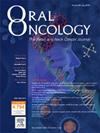IF 4
2区 医学
Q1 DENTISTRY, ORAL SURGERY & MEDICINE
引用次数: 0
摘要
INVERT试验是一项前瞻性、单中心、原理验证的2期临床试验,评估了可切除的局部晚期口腔鳞状细胞癌(LAOCSCC)患者接受新辅助化疗(CRT)的安全性和有效性。手术在 CRT 6-8 周后进行。主要终点是病理完全反应率(pCR = ypT0N0)。结果2012年2月至2022年9月,28名UICC分期(第7版)IVA-IVB LAOCSCC患者入组;92.1%的患者下颌骨受累。所有患者均接受了 60 Gy 的全 IMRT 剂量。对于所有符合顺铂治疗条件的患者,中间累积剂量为 200 mg/m2 BSA。在意向治疗人群中,pCR 率为 46.4%(n = 13),但未达到主要终点。根据 CTCAE(5 级),我们共记录了 384 例任何级别的不良事件(AEs)和 109 例≥3 级的不良事件(AEs)。手术并发症主要是伤口愈合障碍和出血后,没有4级或5级事件。中位随访28.5个月后,无进展生存期(PFS)、局部控制(LC)、无远处转移(DF)和总生存期(OS)分别为60.7%、89.3%、82.1%和64.3%。pCRPowered by Editorial Manager® and ProduXion Manager® from Aries Systems Corporationsignificantly correlated with improved PFS (p = 0.010) and OS (p = 0.021)。本文章由计算机程序翻译,如有差异,请以英文原文为准。
Neoadjuvant chemoradiation for patients with resectable locally advanced oral cavity squamous cell carcinoma: Results of the prospective INVERT clinical trial
Objective
The INVERT trial is a prospective, monocentric, proof-of-principle phase 2clinical trial evaluating the safety and efficacy of neoadjuvant chemoradiation (CRT) inpatients with resectable, locally advanced oral cavity squamous cell carcinoma (LAOCSCC).
Methods
Eligible patients received intensity-modulated radiotherapy (IMRT) to primarytumor and nodal volumes (60/54/50 Gy in 30 fractions) with concomitant platinumbasedchemotherapy. Surgery was performed 6–8 weeks after CRT. Primary endpointwas the pathological complete response (pCR = ypT0N0) rate. Secondary endpointsincluded R0 resection rate, surgical complications, oncological outcomes, and qualityof life.
Results
Between 02/2012 and 09/2022, 28 UICC Stage (7th edition) IVA-IVB LAOCSCCpatients were enrolled; 92.1 % showed mandibular involvement. All patientsreceived the the full IMRT dose of 60 Gy. For all cisplatin-eligible patients, the mediancumulative dose was 200 mg/m2 BSA. In the intention-to-treat population, the pCR ratewas 46.4 % (n = 13) but did not met the primary endpoint. In total, we recorded 384adverse events (AEs) of any grade and 109 AEs ≥ grade 3 according to CTCAE (nograde 5). Surgical complications were primarily wound healing disorders and postbleeding, with no grade 4 or 5 events. At a median follow-up of 28.5 months,progression-free survival (PFS), local control (LC), freedom from distant failure (DF),and overall survival (OS) were 60.7 %, 89.3 %, 82.1 %, and 64.3 %, respectively. pCRPowered by Editorial Manager® and ProduXion Manager® from Aries Systems Corporationsignificantly correlated with improved PFS (p = 0.010) and OS (p = 0.021).
Conclusion
Neoadjuvant CRT is feasible and safe, achieving high pCR rates in LAOCSCC.pCR was associated with improved outcomes.
求助全文
通过发布文献求助,成功后即可免费获取论文全文。
去求助
来源期刊

Oral oncology
医学-牙科与口腔外科
CiteScore
8.70
自引率
10.40%
发文量
505
审稿时长
20 days
期刊介绍:
Oral Oncology is an international interdisciplinary journal which publishes high quality original research, clinical trials and review articles, editorials, and commentaries relating to the etiopathogenesis, epidemiology, prevention, clinical features, diagnosis, treatment and management of patients with neoplasms in the head and neck.
Oral Oncology is of interest to head and neck surgeons, radiation and medical oncologists, maxillo-facial surgeons, oto-rhino-laryngologists, plastic surgeons, pathologists, scientists, oral medical specialists, special care dentists, dental care professionals, general dental practitioners, public health physicians, palliative care physicians, nurses, radiologists, radiographers, dieticians, occupational therapists, speech and language therapists, nutritionists, clinical and health psychologists and counselors, professionals in end of life care, as well as others interested in these fields.
 求助内容:
求助内容: 应助结果提醒方式:
应助结果提醒方式:


